by Briscoe White | Dec 13, 2010 | Basics, Herbs, Life on the Farm |
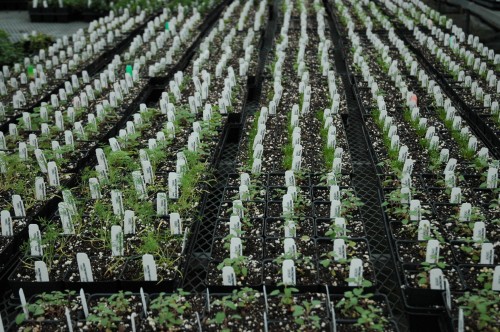
Our seedlings are growing strong!
Though the weather outside is frightful, spring planting can be delightful! Sounds strange, but that is what we are doing here at The Growers Exchange. Seeds were planted several weeks ago and many are now ready to transplant into their final pots. Some plants take a long time to grow from seed, so we start early to insure large well-rooted plants for planting out this coming spring.
Eucalyptus Silver Drop, Feverfew, Comfrey, and others require several months to gain the size and maturity they will need to grow even larger next summer. So, even though it does not feel like spring, we are busy getting ready for when it really does arrive.
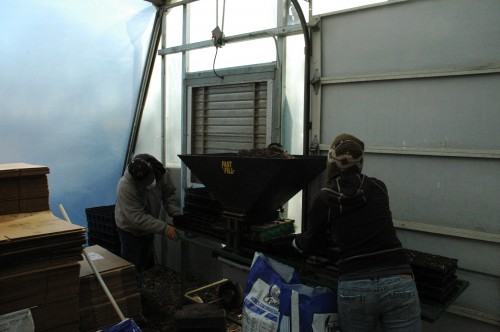
Ino and Annie filling flats!
A good indication of today’s weather is how the greenhouse staff is dressed while filling flats. I hope we don’t need that much clothing much longer!
by Briscoe White | Nov 30, 2010 | Gardening, Life on the Farm, Wildlife |
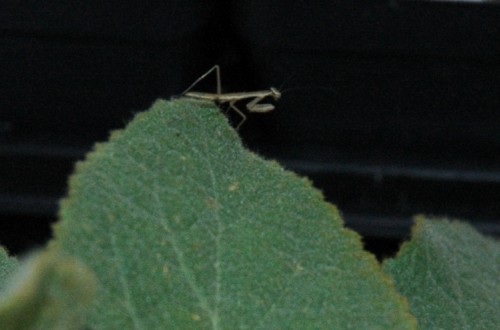
One of our smallest employees at The Growers Exchange!
Our babies have arrived! Our Praying Mantis eggs have hatched! For those of you who didn’t catch our previous blog on natural pest deterrents, we collected Praying Mantis eggs from the cedar trees we use as a wind break and placed them in our greenhouses. While looking at the Comfrey today, we noticed the little Mantises crawling all over the leaves! We looked at the egg sac above the Comfrey and it had hatched. We even found one with a small beetle! Great work little guys, we’re glad to have you on our green team!
Speaking of Comfrey, we have lots that are now going dormant but still have strong root structures. These plants will establish over the Winter and appear in Spring as much bigger plants. For any gardeners still looking for Comfrey this season, we’re putting them on sale soon so keep an eye on our site– and we know they’ll be bug free because we have our little friends tending them!
by Briscoe White | Nov 22, 2010 | Containers, Indoor Gardening, Inspiration, Miscellaneous |
As the holidays quickly approach, we’ve started thinking about some of our favorite aromatic herbs that will help bring your home to life this season. It’s time to toss out those artificially scented candles and store bought fragrances and go all natural instead!
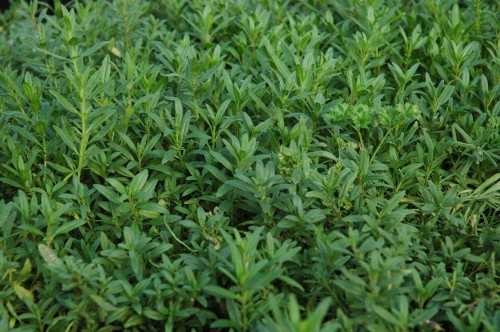
Hyssop
Hyssop has a long been popular for its warm anise fragrance. Used originally by the Ancient Greeks to cleanse their homes and temples of evil spirits and misfortune, Hyssop’s rich sweet smell continues to permeate homes across the world. A terrific medicinal herb as well, Hyssop has proven in modern medical trials that it may act as an herbal deterrent to symptoms of HIV. A member of the Mint family, Hyssop makes a wonderful addition to any wreath or centerpiece for an all natural perfume as inviting as the smell of holiday cooking!
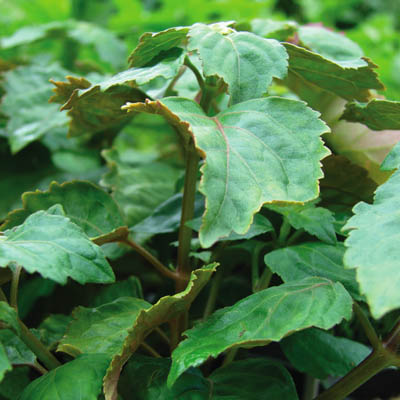
Patchouli
Another cousin from the Mint family, Patchouli has been a friendly favorite well before Woodstock! Patchouli’s leaves are chocked full of its warm, earthy aroma and its essential oils are used by many as an herbal perfume. When warmed, these oils emit a stronger fragrance. Try dabbing a little on a cooled sixty watt light bulb, and once turned on, the smell of Patchouli will begin to heat and waft throughout your home! Patchouli oil also makes a great skin conditioner to help keep your skin soft and supple against abrasive winter winds. Try introducing this sweet scent of the Sixties to your family this holiday season by mixing it in with wreaths or centerpieces!
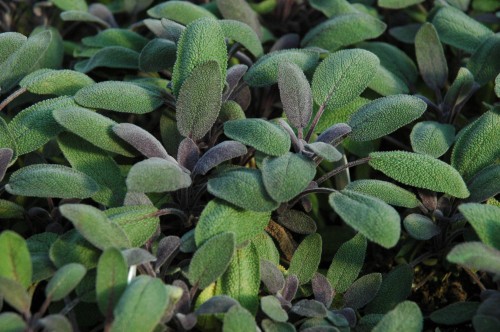
Sage
You may be familiar with tried and true Sage varieties that make great culinary companions like Garden Sage, but for gorgeous centerpieces and fragrant house plants, try planting Purple Sage! Slightly less aromatic than Garden Sage, Purple Sage makes up in beauty what it may lack in scent. With alternating green and purple leaves that grow more vibrant as cooler weather sets in, Purple Sage will make a terrific addition to any wreath or holiday decoration. The dusty purple contrasts nicely with Magnolia leaves, Evergreens and Hyssop and the faint scent of camphor will remind you of a home cooked meal.
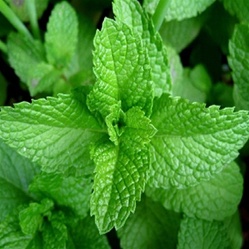
Mint
For a more traditional holiday smell, celebrate the season with Mint! Used in many holiday drinks, Mint is an extremely fragrant herb that conjures memories of candy canes and visions of sugar plums. Whether added to hot chocolate, utilized in a savory centerpiece or just grown in a decorative pot or container, Mint makes a great holiday scent. The menthol in Mint’s essential oils will bring a cool, fresh breath to your home during those stuffy winter months. Try a modern twist on an old favorite herb and give the spicy Cuban Mojito Mint or lemon-scented Citrus Kitchen Mint a try!
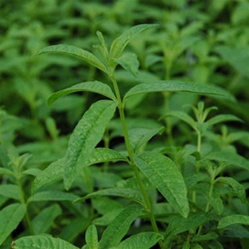
Lemon Verbena
Lemon Verbena blends pleasantly with the Mentholated smell of Mint to really make your home smell cool and clean! Terrific in teas Lemon Verbena has a strong lemon scent that will remind you of Summer, all Winter long. Whether used in holiday decorations, family meals or just grown on a sunny window sill, Lemon Verbena will be a delight all season long. For a blend of citrus perfumes, try creating a tea or arrangement with Lemon Verbena and Citrus Kitchen Mint. Let sunny Lemon Verbena chase away the Winter blues!
by Briscoe White | Nov 8, 2010 | Gardening |
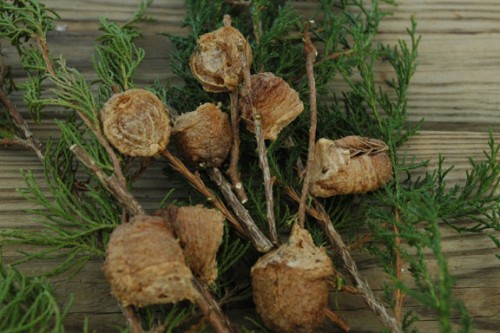
Now that cool temperatures are finally here, we keep the big vent on the greenhouse closed. Even with netting, our fans manage to pull some small insects into the greenhouse all summer. We cannot control the greenhouse environment until it is cold outside. And now that we are closed up for winter, Every gardener hopes these relentless hunters will prowl their plants, keeping the garden free of plant pest.
Praying Mantis egg cases are easy to find on young cedar trees. Each of these has thousands of eggs waiting for warm temperatures to hatch. We hang the egg cases around the greenhouse and wait for the day our pest control helpers arrive. Though we have invited these insect helpers in for many years, never have we measured how long it takes the little mantises to hatch. This year we will be watching! Stay tuned for the conclusion of this greenhouse version of the movie “Predator”. Just be glad they are too small to hunt us!
by Kenan White | Sep 23, 2010 | Basics, Gardening |
Keeping a journal of what goes on in the garden is a great way to keep a record of past events and how the garden grows. By looking back, one can better remember past weather and compare to how current weather may be affecting plants and more generally why the garden is as it is. As it is now, here in Tidewater, Virginia it is really hot and really dry. We haven’t had a really good rain since sometime in spring. So for me as a gardener there has been little exciting to write about; dragging hoses is not very interesting – I know some people who have had this lawn service richmond va company come out and put an irrigation system in their lawns to help with maintaining the grass, among other things, but we’re determined to do it all ourselves. We have not planted our fall salad patch just because it is too hot and dry for success!
One thing I have done is plant some herb plants in clay pots; diameters are from 6 to 8 inches. These potted herbs are growing on my back step, a place with plenty of morning sun and access to water. The drought has made fall planting an unappealing venture, so gardeners may have to change their seasonal patterns while planting this fall. Normally my fall herbs would be planted in a ground bed, but success does not seem likely because it would be hard to water often.
Even with the dry conditions, the growing season ticks on, getting closer to winter each day. So as any gardener knows, timing is everything. If we want things like fresh herbs in winter, we must plant soon or the growing season will fade. To get plenty of fresh herbs this winter, they must be mostly grown before winter. No amount of lighting or heat can match real sunshine. If your garden is as fried as mine, consider a small collection of potted herb plants, and work around the drought.
by Briscoe White | Jun 25, 2010 | Flowers, Gardening |
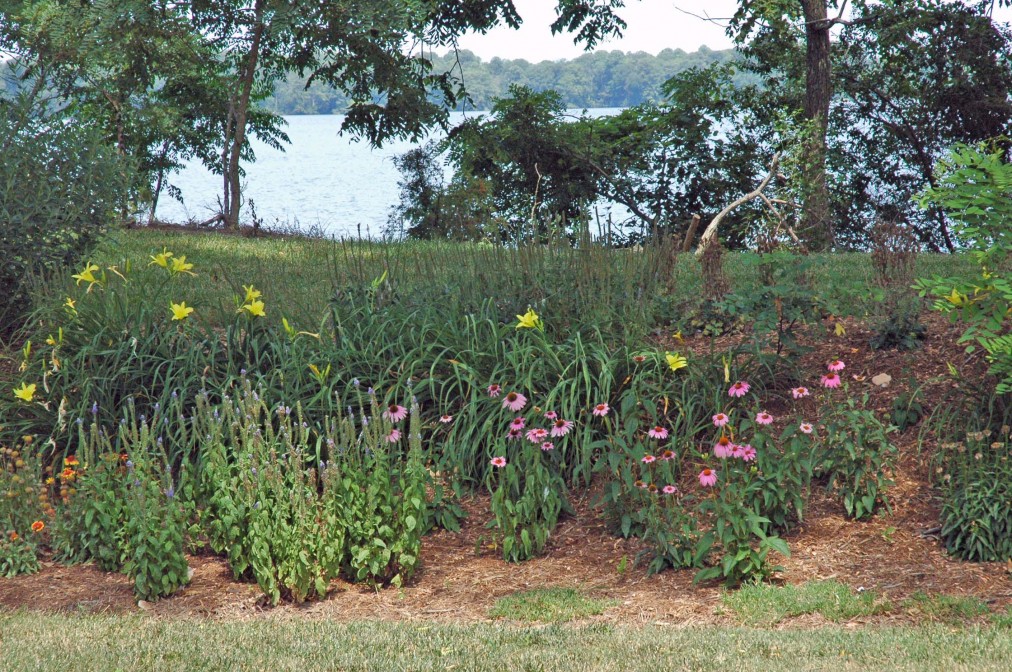

After every season there are always some plants that did not find a home. In the greenhouse, we have to be merciless and allow no survivors at the end. Plants that are divided or potted up are spared because they have found a new reason for being in the next season. Left over annual plants fill our containers.
So, sometimes we are left with perfectly good plants with nowhere to go. Here is where the lucky ones end up. A lot are planted around our farm; we have learned to concentrate planting where they can be tended a little. The hot dry summer is a threat to all new planting unless water is available. Our beds are along the entrance road and around living areas.
The picture shows what we did with some left over perennials. A low drop off behind our pool and always been an eyesore; hardly anything would grow there. Some Ansomnia had grown to very large clumps and a few daylilies hung from the steepest part. I had to water several times a week to get the plants through summer, but it was worth the effort. So, last summer, with the assistance of some hardworking just-graduated seniors, we were able to give those leftovers a second chance. Now, in the INTENSE heat of our end of June days (yesterday was 101!) this bed is hanging on with little to no attention. Notice the coneflowers?











